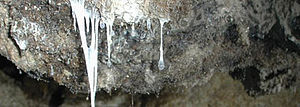Benutzer:Elfabso/Snottit
Wenn du dies liest:
|
Wenn du diesen Artikel überarbeitest:
|

Snottit (englischsprachig: Snottite oder Snoticle) ist ein Biofilm einzelliger extremophiler Bakterien, die in Höhlen wie kleine Stalaktiten von Wänden oder der Decke herabhängen. Die Konsistenz erinnert an Schnodder, woher auch der Name herrührt.
Beschreibung
In den Frasassi-Höhlen in Italien wurden über 70 % der Snottitzellen als das Bakterium Acidithiobacillus thiooxidans identifiziert. Zudem machten
In the Caves in Italy, over 70% of cells in Snottite have been identified as , with smaller populations including an archaeon in the uncultivated 'G-plasma' clade of Thermoplasmatales (>15%) and a bacterium in the Acidimicrobiaceae family (>5%).[1]
The bacteria derive their energy from chemosynthesis of volcanic sulfur compounds including H2S and warm-water solution dripping down from above, producing sulfuric acid. Because of this, their waste products are highly acidic (approaching pH=0), with similar properties to battery acid.[2] Researchers at the University of Texas have suggested that this sulfuric acid may be a more significant cause of cave formation than the usual explanation offered of the carbonic acid formed from carbon dioxide dissolved in water.[3]
Snottites were brought to attention by researchers Diana Northup and Penny Boston studying them (and other organisms) in a toxic sulfur cave called Cueva de Villa Luz (Cave of the Lighted House), in Tabasco, Mexico. The term "snottite" was given to these cave features by Jim Pisarowicz in 1986.
The BBC series Wonders of the Solar System saw Professor Brian Cox examining snottites and positing that if there is life on Mars, it may be similarly primitive and hidden beneath the surface of the Red Planet.
Literatur
- Louise D. Hose & James A. Pisarowicz: Cueva de Villa Luz, Tabasco, Mexico: Reconnaissance Study of an Active Sulfur Spring Cave and Ecosystem. In: Journal of Cave and Karst Studies. Band 61, Nr. 1, 1999, S. 13–21.
Siehe auch
Einzelnachweise
- ↑ DS Jones, HL Albrecht, KS Dawson, I Schaperdoth, KH Freeman, Y Pi, A Pearson, JL Macalady: Community genomic analysis of an extremely acidophilic sulfur-oxidizing biofilm. In: ISME J. 6, Nr. 1, 2012, S. 158–70. doi:10.1038/ismej.2011.75. PMID 21716305. PMC 3246232 (freier Volltext).
- ↑ BBC Two - Wonders of the Solar System, Original Series. In: BBC Online. 4 Apr 2010.
- ↑ Derasa, "Caves and snoticles", Earth-pages, Wiley-Blackwell, 1 May 2004.